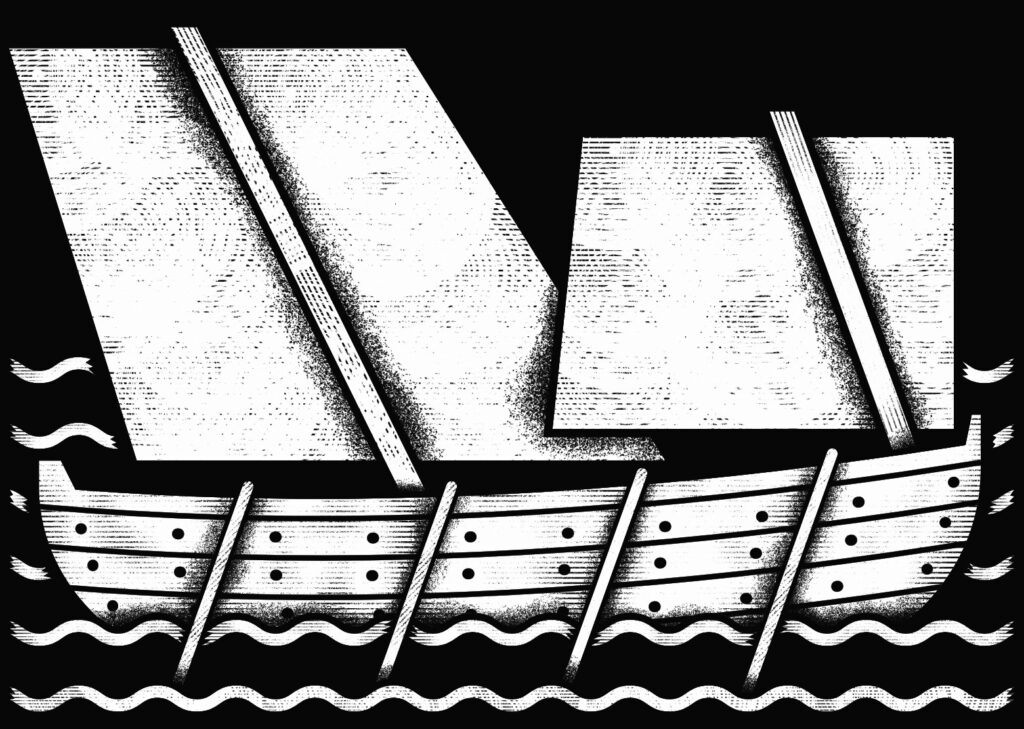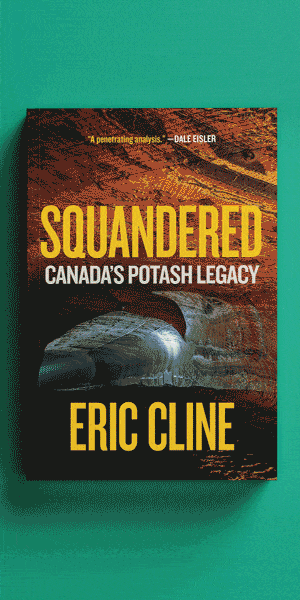In 1983, at Red Bay, Labrador, archeologists for Parks Canada recovered a well-preserved boat that sank in 1565. About twenty-six feet long and six and a half wide, the graceful craft of oak and pine could move by oars or sails. The builders were Basques, from the Bay of Biscay along the north shore of the kingdom called Spain. During the sixteenth and seventeenth centuries, hundreds of Basques annually crossed the Atlantic to harvest codfish, whales, and seals from temporary base camps built on the shores of Labrador and the Gulf of St. Lawrence. In their ships, they brought along the materials to assemble smaller working boats of the sort found by the archeologists. Called a txalupa by the Basques, this sort of boat was a chaloupe to the French and a shallop to the English. (With a crew of five, a recent replica sailed hundreds of kilometres at the brisk pace of fourteen knots under sail.)
The Basques loom small in our histories because they never established permanent agricultural settlements that would grow into colonies to displace original populations. On the contrary, the sojourning Basques developed close relations with Mi’kmaq, Inuit, and Iroquoian groups. Waging trade instead of war, the Indigenous people exchanged furs and meat for metal tools and chaloupes. Some simply helped themselves to boats left behind by Basques at the fall end of the fishing season. By the early seventeenth century, European mariners routinely found them sailing dozens of boats in pursuit of game, fish, and enemies. Learning from the Basques, some Mi’kmaq built their own sailing craft. In 1607, Membertou, a Mi’kmaw chief, assembled about sixty chaloupes at the French colony of Port Royal to ferry 400 warriors 350 kilometres across the Gulf of Maine to attack their enemies, the Abenaki, at Saco.

Plying the unchartered waters of North American history.
Matthew Daley
Basque fishers and Indigenous sailors come as surprises that do not fit our traditional histories of early Canada. This compelling story appears in an intriguing essay by Brad Loewen within a new collection entitled Before Canada: Northern North America in a Connected World, edited by Allan Greer, recently retired from McGill University. One of North America’s premier historians, Greer has written extensively and insightfully about First Nations, French colonization, and the political development of Canada as a nation. In Before Canada, he assembles ten essays by authors from diverse scholarly disciplines including history, literature, geography, and archeology.
The book imagines a deeper history for Canada, stretching back thousands of years before colonization by Europeans. The authors renounce the standard teleology that treats First Nations as exotic primitives briefly mentioned in books and university courses that race to get to Confederation before lingering on the twentieth century. This collection seeks, in Greer’s words, to recover the world of Indigenous and early colonial peoples “on their own terms and not as precursors of a modern territorial polity.”
Greer’s provocative introduction posits Canada as a vast but cohesive physical space with a deep history of its own — a land more fundamental than the nation-state created in 1867. He insists that from Pacific to Atlantic, the northern third of ancient North America had a unity based on “a primordial experience of being scraped and crushed by the greatest ice sheets in the world,” followed by epic floods as the vast glaciers melted about 20,000 years ago. As the ice receded, humans migrated from Northeast Asia to settle the subarctic regions and diversify into hundreds of First Nations in the original Canada.
Greer argues that the vast northern region remained distinctive and cohesive despite the colonial intrusion of Europeans that began in the sixteenth century. In contrast to points further south, this Canada remained primarily “an Indigenous space” as the northern climate limited colonization to relatively small numbers of fishers, whale hunters, fur traders, and loggers. “Through the long centuries of the European invasion, most of Canada felt the effects of imperial-commercial penetration and resource extraction rather than literal settler colonization,” Greer declares. From the sixteenth century well into the nineteenth, northern North America lingered as “a site where thinly extended European empires interacted with independent Indigenous nations.” He seeks to correct the myopic modernism of historians “interested in only the narrowest temporal slice of that very long timeline, as though the history of Canada were scarcely more than the history of the territorial state and its immediate colonial antecedents.”
The essays cannot fulfill the ambitious agenda introduced by Greer. Each is written by a specialist in one discipline and a single subregion, so they pursue disparate and limited goals. Most focus on the eastern littoral of Canada, the maritime approaches to the St. Lawrence Valley during the earliest stages of colonial penetration. Only one author, John W. Ives, examines the western two-thirds of Canada. And he undercuts its cohesion as a single yet distinctive region by detailing the migration of Athapaskan peoples from Alaska into western Canada and then deep into the future southwest of the United States.
Written for readers who live within Canada today, the book projects backwards in time a “Canada-as-physical-space.” But was there ever a Canada before Canada, meaning a cohesive land from sea to sea to sea defined by a shared nature and a common history? Greer emphasizes mass glaciation and imperial resource extraction within a lingering Indigenous world, but both processes also characterized the northern quarter of the United States, particularly in its western quadrant. And that says nothing of Alaska, which he can exclude only because it’s not now within Canada the nation. Porous to the south and the northwest, the supposed original Canada also lacked unity within, for the Pacific and Atlantic sub-regions had radically different climates, landscapes, and cultures — and both shared little with the vast continental territory between them. Despite Greer’s impressive effort, his ancient Canada remains defined by the current bounds of a nation-state rather than by a shared nature, geography, and deep history. Only in the nineteenth century would some northern parts of the continent (excluding Alaska) come together in a British imperial project to create a country that would not be the United States. It is easier to denounce than to exorcise the nationalism that informs how modern readers and their historians define where they live and how they got there.
Instead of examining one common land, the essays find unity by reframing older stories with new angles of vision created by a deeper sense of time and a wider attention to geography. For example, Jack Bouchard recasts the sixteenth-century development of the Newfoundland fishery as connected to earlier and similar European expeditions to Brazil, the Caribbean, West Africa, Iceland, and Greenland. He concludes (with my emphasis added), “We must see that Newfoundland arose out of an early Atlantic world but also remained embedded in it. . . . We should see Newfoundland as a culminating, rather than a starting, point — those who made a fishery were building on deeper processes of maritime experience and food production.”
With a similar shift of perspective, Adrian L. Burke and Christian Gates St‑Pierre reinterpret archeological evidence to detect trade networks linking many First Nations in peaceful relationships over hundreds of years and kilometres. Created millennia ago, these networks were creative and dynamic —“expanding and contracting, and eventually fading or being replaced by other networks.” The authors challenge old stereotypes of isolated, violent, and stagnant peoples trapped in a primitive stone age. They conclude that early colonizers had to insert themselves into a complex “Indigenous geopolitical landscape.”
Lisa K. Rankin re-examines the early contacts of European mariners with Inuit along the coast of Labrador. She recovers the long history of Inuit development and migration from the north shore of Alaska around to Labrador during preceding centuries. That perspective enables Rankin to recast European trade goods as “incorporated in ways that continued to support a dynamic Inuit cultural system.” Inuit remained true to their adaptive culture while wearing some European clothes and using metal fishhooks.
Helen Dewar redefines the early French empire as preoccupied with maritime trade rather than with terrestrial colonization. Out to increase Crown revenue while minimizing administrative costs, early French imperialists readily left most of the North American interior alone as enduring “Indigenous spaces of cultural and political power.” The literary scholar Katherine Ibbett examines that same maritime orientation to explain the popularity of shipwreck survival tales. Mary Fuller similarly views the early English geographical imagination as focused on coasts and oblivious to the continental interior of North America. All three of these essays highlight the myopia of European conceptions and the limits of colonial reach, save for those alluring trade goods that entered Indigenous hands apparently on Indigenous terms.
The outlier essay comes from Allan Greer and Samuel Derksen, who re-examine the fur trade that penetrated deep into the continent. They challenge the old Harold Innis vision of heroic traders discovering and transforming a continent to create the Canadian nation. But Greer and Derksen also dissent from newer notions of the fur trade as largely benign for Indigenous peoples. They note that traders operated “far from the enclaves of colonial settlement and well beyond the reach of European jurisdiction and sovereignty . . . in Indigenous-controlled territories.” Yet those traders imposed a quantitative calculation of individual debt that contradicted traditional notions of long-term reciprocity. By doing so, they worked to reduce communities to dependency on the capitalist market. How did the traders do so without the support of imperial troops and courts? Greer and Derksen answer that they promoted addiction to alcohol and used selective violence to isolate and punish those who did not cooperate. Empires may have been weak, but capitalism had an insidious and corrosive influence far beyond the colonial settlements. Greer and Derksen seek to correct a newer scholarship that sees only the limits of European power within North America — the very scholarship practised by the other writers in this collection.
Greer wisely declines to add a conclusion to the book, for the essayists offer such varying takes on diverse parts of Canada’s deep past. Herding academic cats can go only so far. For more, we should wait for the completion of Greer’s larger project: “an overview of Canada’s deep history.” Given the quality of this collection and the ambition and balance of Greer’s vision, that overview will be worth the wait.
Alan Taylor recently published American Civil Wars: A Continental History, 1850–1873.

